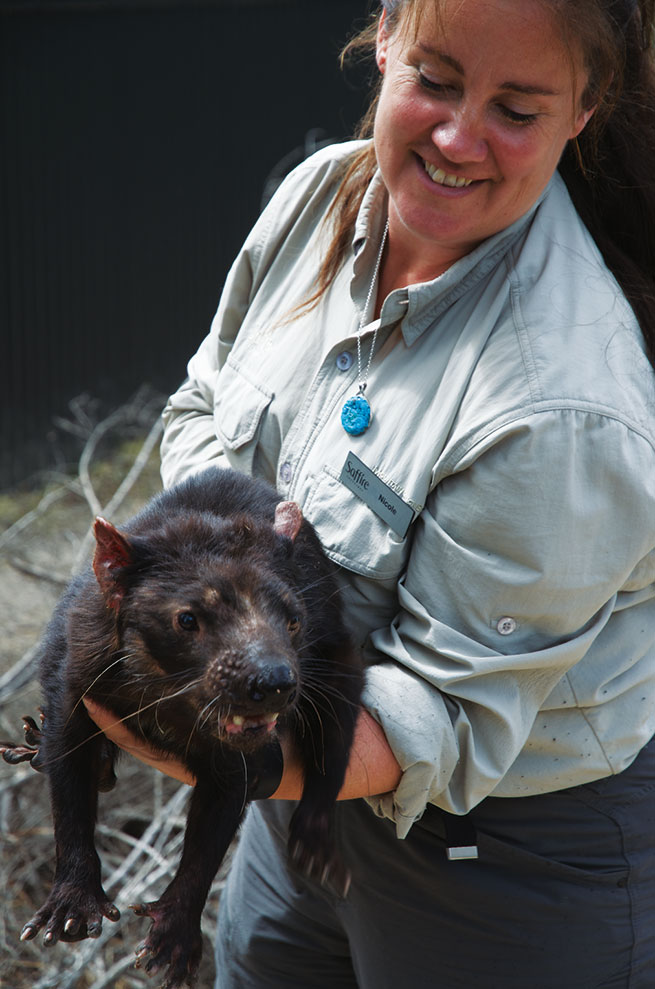
Elspeth Callender finds the guests at a Tasmanian super lodge are offered the opportunity to get closer to nature, including the island’s endangered little devils.
There’s something about Murray that makes me want to adopt him. He’s small, wiry, a bit unsteady on his feet and has to be isolated for meals because his mates hog all the food. Not necessarily take him home, just adopt. Falling for this little devil came as easily as feeling close to nature while at Saffire Freycinet, though both were unexpected outcomes of a luxury lodge stay.
While fresh to Saffire, I’ve visited and explored the Freycinet Peninsula on Tasmania’s east coast many times in varied weather, but the Hazards never seem to lose their impact. Dramatically framed though the expansive glass wall of Saffire’s reception area, which curves at the ceiling like a mountaintop, they appear more beguiling than ever.
After I’ve settled into my luxury suite, it’s time to meet some little devils, the Tasmanian variety. Activity guide Nicole Dyble leads us to the fenced enclosure surrounding one hectare of bushland – mainly blue gums, banksias and grass trees – where four lucky devils live in seagrass-lined dens. Solitary creatures, except for sex and snacks, they race in to the viewing window on hearing the devil wrangler’s voice. One plonks on the sunny sill.
This enclosure (along with devils Moinee, her sister Weenie, and Malcolm and his scrawny brother, Murray) has been a feature of Saffire for about a year. The devils guard, squabble over and devour their favourite edibles while we learn about the world’s largest carnivorous marsupial.
These often-misunderstood animals are opportunistic scavengers. Devils are quite predictable, silent if eating alone, have a jaw/bite force in relation to body mass that rates them among the top mammal land predators, and can consume nearly half their body weight in about 30 minutes.
Devils died out on mainland Australia long ago (between 400 and “thousands of years ago”) and have recently faced total extinction due to Devil Facial Tumour Disease (DFTD). This infectious form of cancer spreads easily between animals that instinctively bite each other’s faces and, once tumours develop, life expectancy is six months.
A statewide initiative to find a cure for DFTD is seeing some success, but government funding has run out. Saffire’s contribution, Dyble explains, is “providing housing for the oldies”. Accommodating these devils (previously involved in the breeding initiative but now past reproductive age and unaccustomed to living wild) frees up room in breeding facilities. Three more females are booked to arrive soon.
Saffire guests can further help by adopting a devil, and all contributions go directly to Save the Tasmanian Devil Program and Menzies Research Institute of Tasmania.
The next morning, after breakfast, I join a group for a short Freycinet walk and am happy to find that Nicole is our guide again. She knows how to provide digestible detail without oversimplifying, but can expand on certain points as questions arise.
From the van down to Sleepy Bay it’s no more than 10 minutes of walking, but we stop to discuss the growth rate of giant kelp and the necessity of bushfires for banksia regeneration and watch a flame robin flit through the casuarinas. Sleepy Bay is tranquil today, although the scarred beach boulders suggest the swell is rarely so slack.
From the walkway at Cape Tourville we gaze south across Thouin Bay to the entrance of Wineglass and hear about the Oyster Bay people who lived and hunted on this peninsula and whose middens remain visible along its coastline. The final stroll is to Honeymoon Bay, right beside the Hazards. Another of Saffire’s popular complimentary experiences is birdwatching from sea kayaks in the Swanport estuary. Activities coordinator Joel Daltry tells me they generally spot red knots, sooty oystercatchers, sea eagles, black swans and herons.
Meanwhile, back at the lodge, a narrow path leads through the lightly landscaped native vegetation, which merges seamlessly with the bushland, down to the beach for swimming, fishing off the rocks or walking to Coles Bay.
Similarly, Saffire’s interior doesn’t display artworks or furniture to draw attention to another time or place – the predominant view from suites and communal areas is raw Tasmanian land- and seascape. The fluidity between being inside and out at Saffire is often aspired to, but rarely achieved by high-end accommodation in natural settings. Hotels tend to overly preen the surrounding environment, plant introduced species and attempt to buffer guests from the elements. Saffire is an elegant observation platform to nature that also facilitates active as well as passive interaction with that view.
Even if you don’t go wading around an oyster farm, join a ‘connection to country’ beach stroll or stretch your arms at the archery range, just walking to meals gets you out in the fresh air, the suites have couches positioned perfectly for stargazing and that Tasmanian devil Murray’s blinds are always open.
Tasmanian devil at Saffire | Elspeth Callender
Latest Articles
Don't miss the latest from Luxury Travel
